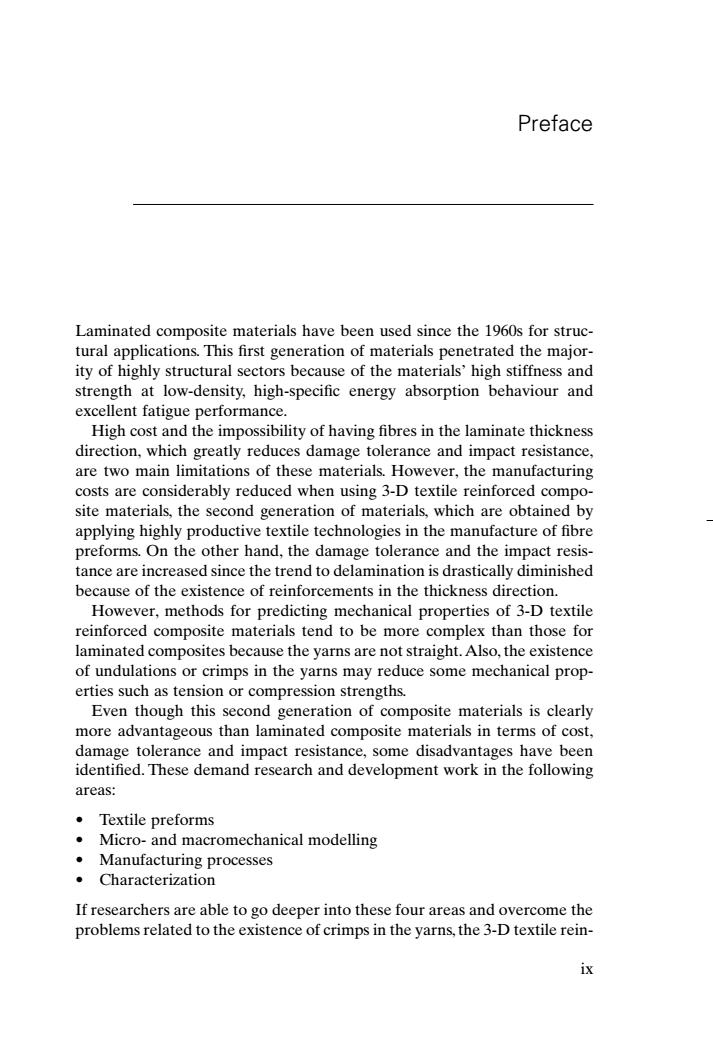正在加载图片...

Preface Laminated composite materials have been used since the 1960s for struc- tural applications.This first generation of materials penetrated the major- ity of highly structural sectors because of the materials'high stiffness and strength at low-density,high-specific energy absorption behaviour and excellent fatigue performance. High cost and the impossibility of having fibres in the laminate thickness direction,which greatly reduces damage tolerance and impact resistance, are two main limitations of these materials.However,the manufacturing costs are considerably reduced when using 3-D textile reinforced compo- site materials,the second generation of materials,which are obtained by applying highly productive textile technologies in the manufacture of fibre preforms.On the other hand,the damage tolerance and the impact resis- tance are increased since the trend to delamination is drastically diminished because of the existence of reinforcements in the thickness direction. However,methods for predicting mechanical properties of 3-D textile reinforced composite materials tend to be more complex than those for laminated composites because the yarns are not straight.Also,the existence of undulations or crimps in the yarns may reduce some mechanical prop- erties such as tension or compression strengths. Even though this second generation of composite materials is clearly more advantageous than laminated composite materials in terms of cost, damage tolerance and impact resistance,some disadvantages have been identified.These demand research and development work in the following areas: ·Textile preforms Micro-and macromechanical modelling Manufacturing processes Characterization If researchers are able to go deeper into these four areas and overcome the problems related to the existence of crimps in the yarns,the 3-D textile rein- ixPreface Laminated composite materials have been used since the 1960s for structural applications. This first generation of materials penetrated the majority of highly structural sectors because of the materials’ high stiffness and strength at low-density, high-specific energy absorption behaviour and excellent fatigue performance. High cost and the impossibility of having fibres in the laminate thickness direction, which greatly reduces damage tolerance and impact resistance, are two main limitations of these materials. However, the manufacturing costs are considerably reduced when using 3-D textile reinforced composite materials, the second generation of materials, which are obtained by applying highly productive textile technologies in the manufacture of fibre preforms. On the other hand, the damage tolerance and the impact resistance are increased since the trend to delamination is drastically diminished because of the existence of reinforcements in the thickness direction. However, methods for predicting mechanical properties of 3-D textile reinforced composite materials tend to be more complex than those for laminated composites because the yarns are not straight.Also, the existence of undulations or crimps in the yarns may reduce some mechanical properties such as tension or compression strengths. Even though this second generation of composite materials is clearly more advantageous than laminated composite materials in terms of cost, damage tolerance and impact resistance, some disadvantages have been identified. These demand research and development work in the following areas: • Textile preforms • Micro- and macromechanical modelling • Manufacturing processes • Characterization If researchers are able to go deeper into these four areas and overcome the problems related to the existence of crimps in the yarns, the 3-D textile reinix RICPR 7/10/99 7:08 PM Page ix